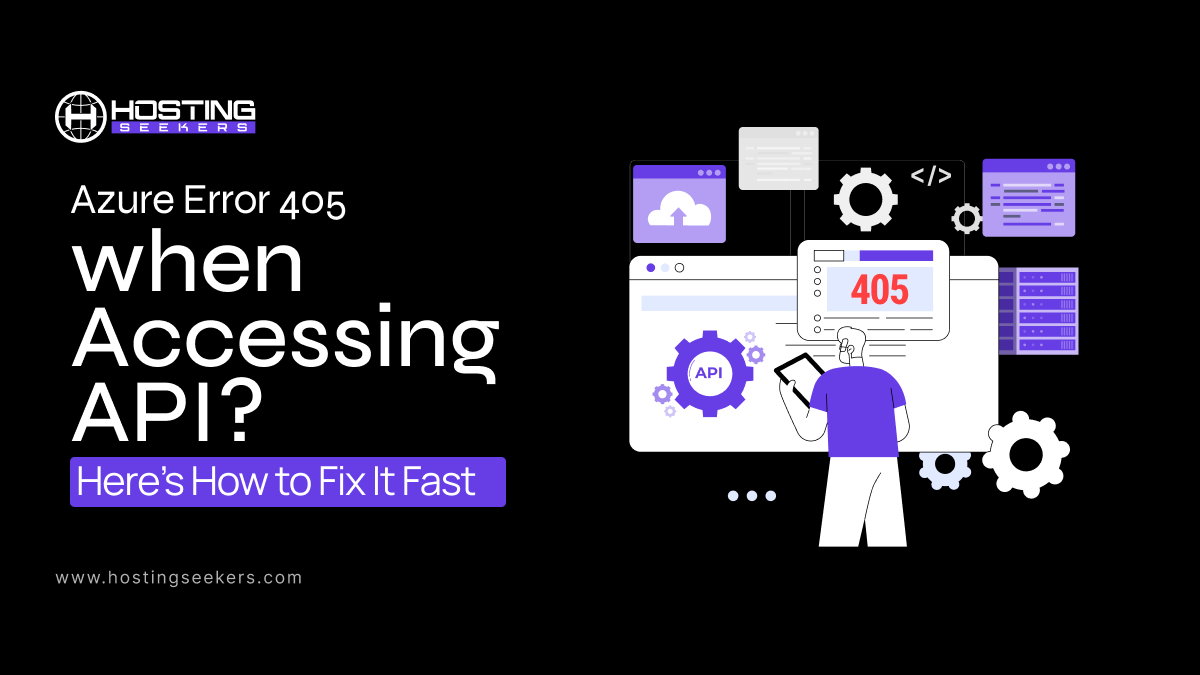
Azure Error 405 When Accessing API? Here’s How to Fix It Fast
Error Updated on : November 25, 2025Azure Error 405 is a common and confusing issue that developers encounter when calling APIs in Azure. It occurs when the server recognizes your request but blocks it because the HTTP method (GET, POST, PUT, DELETE, etc.) is not permitted for that endpoint. The tricky part is that everything else, like your URL, deployment, or API tests in Postman, may look perfectly fine. Yet the same request fails in production, on the frontend, or inside APIM.
This blog breaks down what causes Azure Error 405 across services like Azure Functions, APIM, App Services, and Static Web Apps, and shows you exactly how to fix it quickly.
What Is Azure Error 405?
Azure Error 405 means “Method Not Allowed.” When Azure returns this code:
- The server correctly understands your HTTP request (valid URL, headers, body, etc.).
- The API endpoint exists (not a 404).
- But the HTTP method (GET/POST/PUT/DELETE) is not permitted for that endpoint.
Key Debugging Tip: Every 405 response includes an Allow header showing which HTTP methods actually work.
Example:
text
HTTP/1.1 405 Method Not Allowed
Allow: GET, POST, OPTIONS
Content-Type: application/json{ “error”: “Method not allowed”, “message”: “This API endpoint only supports GET and POST requests” }
How 405 Differs from Other API Errors
Developers often confuse 405 with other HTTP status codes. Here’s how to distinguish them:
| HTTP Code | Meaning | API Example | Fix |
| 400 | Bad Request | Sending invalid JSON body to POST /api/products | Check request format, validate JSON syntax |
| 401 | Unauthorized | No API key in header for POST /api/products | Add a valid authentication token/API key |
| 403 | Forbidden | Valid token but no access to resource | Request elevated permissions or a different API key |
| 404 | Not Found | Requesting /api/wrong path that doesn’t exist | Check the correct API endpoint URL |
| 405 | Method Not Allowed | Sending DELETE to /api/products (GET/POST only) | Use the correct HTTP method (GET instead of DELETE) |
| 500 | Internal Server Error | Unhandled exception in backend code | Check server logs, fix backend error |
Real Error Messages
IIS / App Service:
HTTP Error 405.0 – Method Not Allowed: The resource does not support the specified HTTP verb.
APIM:
“Method not allowed.” Or, incorrectly, “404 Not Found” when the operation isn’t defined.
Functions:
JSON response showing status 405 and allowed methods.
Browser/Front-end:
“Access blocked by CORS policy: Response to preflight request had HTTP status code 405.”
Common Causes (By Platform)
1. Wrong HTTP Method
Sending a method not defined for the endpoint (e.g., trying DELETE where only GET/POST is allowed).
Fix:
Check docs/OpenAPI for allowed methods.
Use curl:
text curl -i -X DELETE https://api.azurewebsites.net/api/products/123
If Allow: GET, POST is returned, DELETE will not work.
2. StaticFile Handler Conflicts (App Service/IIS)
Routes with .html or other static file extensions get handled by StaticFile, which only supports GET/HEAD. Non-GET verbs fail with 405.
Fix:
Use /api/* routes for APIs and make sure web.config handlers separate static files from APIs:
xml
<system.webServer>
<handlers>
<add name=”StaticFile” path=”*.html” verb=”GET,HEAD” />
<add name=”aspNetCore” path=”/api/*” verb=” GET, POST, PUT, DELETE, OPTIONS” />
</handlers>
</system.webServer>
3. WebDAV Publishing Interference
WebDAV (enabled by default on some IIS servers) can block PUT/DELETE, causing 405.
Fix:
Remove WebDAV from web.config:
xml
<modules>
<remove name=”WebDAVModule” />
</modules>
<handlers>
<remove name=”WebDAV” />
</handlers>
4. CORS Preflight (OPTIONS) Request Failure
Browser-based API calls send a preflight OPTIONS request before POST/PUT/DELETE. If OPTIONS isn’t handled, you’ll see a 405 (and browser blocks the actual request).
Fix:
For Functions, include “options” in function.json:
json
“methods”: [“get”, “post”, “options”]
Respond to OPTIONS in your backend code, e.g., Node.js:
js
if (req.method === “OPTIONS”) {
res.status(200).set({
‘Access-Control-Allow-Origin’: ‘*’,
‘Access-Control-Allow-Methods’: ‘GET, POST, OPTIONS’,
‘Access-Control-Allow-Headers’: ‘Content-Type, Authorization’,
‘Allow’: ‘GET, POST, OPTIONS’
}).end();
}
5. Azure Functions function.json Method Declaration
If your method isn’t in the “methods” array of function.json (MUST BE LOWERCASE), Azure returns 405 even if your code handles it.
Fix:
json
“methods”: [“get”, “post”, “put”, “delete”, “options”]
6. APIM Operation Not Defined
By default, APIM will return 404 for a missing HTTP method unless you override with a 405-response policy.
Fix:
Define the operation (DELETE, PUT, etc.) in APIM design.
Or use the APIM return-response policy:
xml
<choose>
<when condition=”@(context.LastError.Source == ‘configuration’ && context.LastError.Reason == ‘OperationNotFound’)”>
<return-response>
<set-status code=”405″ reason=”Method not allowed” />
<set-body>
{ “status”: “HTTP 405”, “message”: “Method not allowed” }
</set-body>
</return-response>
</when>
</choose>
7. Missing CORS Headers or Configuration
Frontend browser calls require allowed origins and methods in CORS headers. Otherwise, even allowed requests are blocked as “failed options.”
Fix:
Add headers for CORS:
xml
<add name=”Access-Control-Allow-Origin” value=”*” />
<add name=”Access-Control-Allow-Methods” value=”GET, POST, PUT, DELETE, OPTIONS” />
<add name=”Access-Control-Allow-Headers” value=”Content-Type, Authorization” />
<add name=”Allow” value=”GET, POST, PUT, DELETE, OPTIONS” />
How to Fix Azure Error 405?
1. For API Management (APIM)
1. Check Inbound/Outbound Methods:
Every API operation must allow the required methods. Update OpenAPI/Swagger definitions as needed.
2. Review Policy Overriding:
Check inbound policies (especially ).
3. Implement Error Response Policy:
Use and to force 405 on missing methods (see code above).
4. Validate API Version:
Make sure you are testing against the right API version and endpoint.
2. For Azure Function Apps
1. Add Allowed Methods:
Make sure “methods” in function.json includes every needed verb, all lowercase.
2. Check Authorization Keys:
Pass the required function or host keys properly.
3. Fix Route Templates:
Route/template in function.json must match what the API expects.
3. For Azure App Service ( .NET/Node/Python)
1. Validate Routing:
Use [HttpGet], [HttpPost], etc. on controller methods; double-check templates.
2. Fix the web.config Conflicts:
Remove unneeded WebDAV/module/handler entries; don’t block required methods.
3. Add OPTIONS Support:
.NET Web API might require an explicit [HttpOptions] action; Node.js/Express needs .options() endpoint.
4. For Browser-based (Front-end) Calls
1. Enable OPTIONS:
Backend must return 200 for OPTIONS with proper CORS headers.
2. Check HTTPS Redirection:
Make sure HTTP-to-HTTPS redirects don’t mistakenly block POST/DELETE requests.
3. Configure CORS:
Azure must allow your frontend origin and headers/methods in the CORS config.
Troubleshooting Table
| Cause | Symptom | Root Check | Fix | Prevention |
| Wrong HTTP method | 405 on correct endpoint; Allow header shows different methods | Compare your method vs API docs | Use the correct method matching specification | Document all API methods; validate requests |
| function.json missing method | 405 only in Azure Functions; works locally | Check “methods” | Add method to array (must be lowercase); redeploy | Use templates; always test post-deployment |
| Missing OPTIONS for CORS | 405 on OPTIONS request; browser blocks actual request | Test OPTIONS separately; check preflight in the Network tab | Add “options” to methods; handle OPTIONS in code | Always add OPTIONS; test cross-origin calls |
| WebDAV module enabled | 405 on PUT/DELETE; error shows WebDAVModule | Check the error message for the WebDAVModule reference | Remove WebDAV from web.config | Disable WebDAV in fresh deployments |
| APIM operation not defined | 405 when via APIM, but works directly | Check the APIM Design tab for operation | Add operation definition in APIM | Document APIM operations; test via gateway |
| StaticFile handler conflict | 405 on POST to static assets | Check handlers in web.config | Route APIs through different handlers | Separate API routes from static files |
| Missing CORS headers | CORS error in browser; works in Postman | Test in browser; check Network tab for preflight | Add Access-Control-Allow-* headers | Always include CORS headers in responses |
When to Contact Azure Support?
Most Azure Error 405 issues can be resolved by following the steps outlined in this guide. However, consider contacting Azure Support when:
- You have thoroughly checked API configurations, function.json, APIM policies, and CORS setups, but the 405 error persists.
- Your API works locally or in staging but fails in production, suggesting possible platform or deployment inconsistencies.
- You encounter complex scenarios like multi-region API Management, advanced custom policies, or network configurations, causing inconsistent HTTP method handling.
- There are ongoing Azure service outages or incidents affecting your APIs.
- The 405 error causes urgent production impact, and internal troubleshooting has been exhausted.
Before contacting support, gather: APIM trace logs, function.json files, curl/Postman request and response details, environment info, and a clear description of your troubleshooting steps. These help support the diagnosis and resolution of your issue swiftly.
Conclusion
Azure Error 405 When Accessing APIs occurs when you use an HTTP method that the API endpoint doesn’t support. Whether caused by Microsoft’s 3 documented causes (wrong method, StaticFile handler, WebDAV) or Azure-specific issues (APIM operations, CORS preflight, function.json), the fix is systematic.
Frequently Asked Questions
Q1. What does Azure Error 405 mean?
Ans. Azure Error 405 means the endpoint is valid, but the HTTP method you used (e.g., POST, DELETE) is not allowed. Check the Allow header for what works.
Q2. Why does my API return 405 even though it works in Postman?
Ans. Most often, Postman sends direct requests and does not trigger browser CORS preflight (OPTIONS); your frontend may need OPTIONS enabled and CORS set up.
Q3. How do I fix Azure Error 405 in APIM?
Ans. Define the method as an operation in APIM, and (for missing ops) use a policy to return 405 instead of the default 404 (see code above).
Q4. How do I fix Error 405 in Azure Function Apps?
Ans. Add the method (e.g., “delete”, “put”, “options”) in function.json (lowercase!) and redeploy.
Q5. Can routing or web.config issues cause Azure 405 errors?
Ans. Yes, conflicting handlers, legacy modules (WebDAV), or missing OPTIONS handlers can cause 405. It suggested to always check web.config and controller routing.
Source Link:




